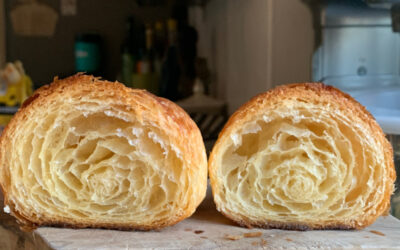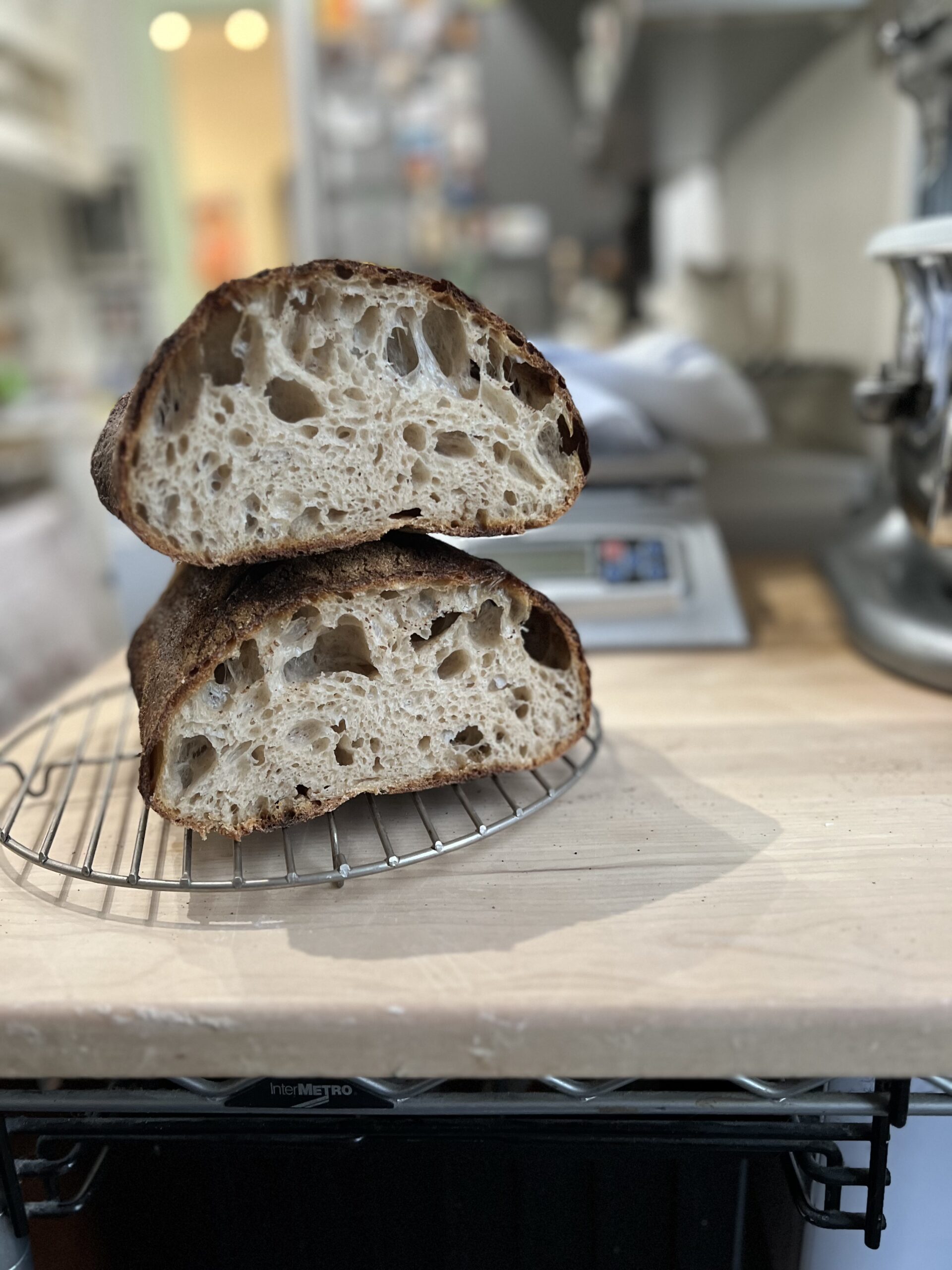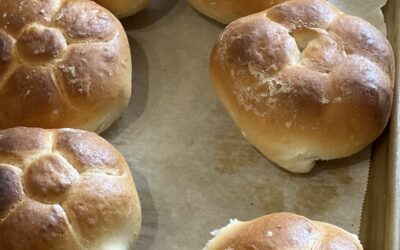It’s been some time since I have followed good baking advice, my own or someone else’s. Being a lazy baker makes me the last authority on deciding with caution or precision on good baking habits and tips. I suppose making mistakes can eventually change bad habits, with the price of flour, fuel being another reason to not make bread headed for the garbage bin instead of your table, so observe and learn.
First, flouring the cane basket with rye flour instead of wheat, why you ask? The case for using rye to flour a proofing basket could be described as just plain common sense. But who am I kiddng? Why just the other day while trying extract a a full 2 lb Miche into a hot creuset pan I found a sort of hanger on of sticky dough clinging to my German cane brot form,(Actually it happened on my last pot bread, but the finished product did not show as pronounced a flaw to make it look as if the loaf was misshapen or defective.) This can be sort of challenging to say the least. Not just the fact of plopping the dough in unceremoniously defies wisdom or just plain sanity. So after yanking the long strand of dough and laying it over the spherical boule like a bald man covering a spot with a long hanging wisp of hair, I plopped back the cast iron cloche into my oven and covered it with it’s lid. Bloody hell!
The second bit of advice, is not to pre-heat your creuset to high, why? Unless you like your loaf sort of on the scorched side and a piece of dough stuck to the bottom of the pan, which would explain why there is a small hole on the bottom of the loaf. Lets just say it happened to me. Of course you could tell your friends that your French instructor from baking class back at school told you to bake the loaves darker for a croustillant quality, to give it that terroir taste or perhaps your researching ash content? Huh!
Since I have just succumbed to the idea that maybe Jim Lahey does have a good idea with his no knead baking in a pot method, however unorthodox; I still find myself combining several different baking techniques and methods. I flirt with the Dan Lepards hand mix, I use my mixer, or sometimes to relieve aggression I’ve used Richard Bertinets slapping and folding technique.
My friend Susan, rightly says to bake you must follow your own senses and not get hung up on rules, so mix and match for me has been useful.
\The Miche is a bread I truly love, it’s the quintessential loaf of true French familial origins. It’s rustique, its nourishing, just great to slice and slather, with it’s deep nutty profile and long shelf life, well it’s a bakers bread. This specimen even with my minor flaws is my favorite formula from Amy Scherber of Amy’s Bread. It was featured in an article from an issue back in April/May 2002 of Pastry arts and design. I disregard the yeast and even retarded the dough due to my scheduling, generally I won’t schedule a bake, bread to me seems so spontaneous,(actually I have a regular job that manages to screw up my baking time, so I am lying about spontaneity.).
In the past I haven’t really liked retarding my dough, up until now. Through observation I found, (can you believe it, I observed, maybe I’m not so lazy after all?), that if you let the dough come back up to temperature, it doesn’t blow out or have a grey looking finish. From my recent efforts, I’ve concluded that it’s not the same to retard the bread in a home refrigerator as it is in a chilled retarding room found in bakeries. The temperature I think in a fridge at home registers say about 35 to 40 degrees. Though I can’t say for sure I am assuming retarders are in the low 50 degree range, that could be the difference? When I was taking a class with Jeffrey Hamelman, he told us that you can plop the dough in cold, hasn’t worked for me but Jeffrey probably could explain why and tell me a thing or two! I shy away from that only for the simple reason, it hasn’t worked for me, so go with instinct or trial and error, but remember every loaf is different. At least I hope they are or it’s wonder bread!





I hardly ever flour with rye unless it’s a rye dough — does rye stick less than wheat flour? I’m going to try it! I have a new favorite word: “croustillant.”
Bertinet’s slap and fold technique is good therapy.
I usually flour banneton with whatever flour the bread is made with. I keep wondering if using a different flour might add an off taste.
Susan,
I usually sift out the rye to get it a little lighter or leave it whole for a rustic look. In my opinion it does work better than wheat flour which seems to absorb a lot into the dough. Croustillant was a word we used for a potato galette we used to make at a restaurant I worked at.
Jude, just saw your Poilaine high extraction, nice. I haven’t noticed a taste difference, though it gives a more rustic look.
Beautiful Miche, Jeremy! As usual, I might add. You bake some really gorgeous bread. Even the burnt bottom is supposed to contribute to the flavor?? I called my last burnt batch, Diablo bread! Have you tried the roasting lid method yet? It is easier than the pan method and you can use your trusty baking stone. I have a blog entry here on it: http://northwestsourdough.wordpress.com/2008/06/02/roasting-lid-baking-method-for-sourdough/
Happy Baking, Teresa
Thanks Teresa,
It tasted great with gouda made from goats milk!
I caught some of your videos this weekend including the pot cover one, just got to find one of those,maybe I could find one in a tag sale?
It’s true the burnt part does impart a nuance in the pallette, sort of deep smoke with the rest of the layers nutty flavor!
Good to see you here again!
Jeremy,
Your miche looks great! You might want to try and use rice flour for dusting your baskets because it hardly absorbs any water. I’ve never had any problems using rice flour with doughs that were highly hydrated or with doughs that were proofed long in baskets in a retarder. When you work with sourdoughs, I was told never to bake it in a high temperature…like 480 F. It requires a lower temperature…like 440 to 460 F. Sourdough moves a bit slower thus…producing a longer oven spring. As for baking with your senses…well there is some validity on that, but if you do bake with your senses, I would suggest making a note of what you did. What I like best is following guideslines. One of the tips I gave you is a guideline that I got from my baking class, and I’ve never threw it away because it has never failed me. You are correct that home refrigerators operate around 35 to 40 F. You might want to try and use a wine cooler as a retarder since it doesn’t really get that cold, but it does not have a humidifier.
Jeremy,
You might want to check out this site about different methods of dough retardation. This might give you a better understanding. I hope it helps.
http://www.sourdoughhome.com/retarding.html
Doughman,
thanks, I think I have got the retarding down, as far as it’s possible in a home fridge and using the parameters I learned at school as well some bakeries I worked at.
Been to that page, Mike Avery right? I have seen him on the bakers guild group forum on yahoo.
Yep, that´s Mike Avery´s homepage, alright. I see that you are still trying different miche formulas. Have you seen this video from the Poilane bakery?
http://www.youtube.com/watch?v=b6vG06VStu4&mode=related&search=
Hey Doughman,
Yep seen it before, (video).
I always try Miche formulas, it’s a great bread with ummph! Amy Scherbers is by far my favorite although my variation on Dan Leaders in a creuset was a close finish!
Do I know you from another forum?
Yep, I frequent on Graham´s site.